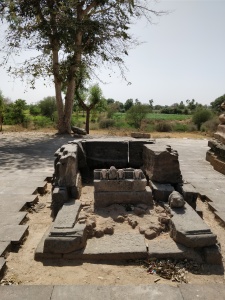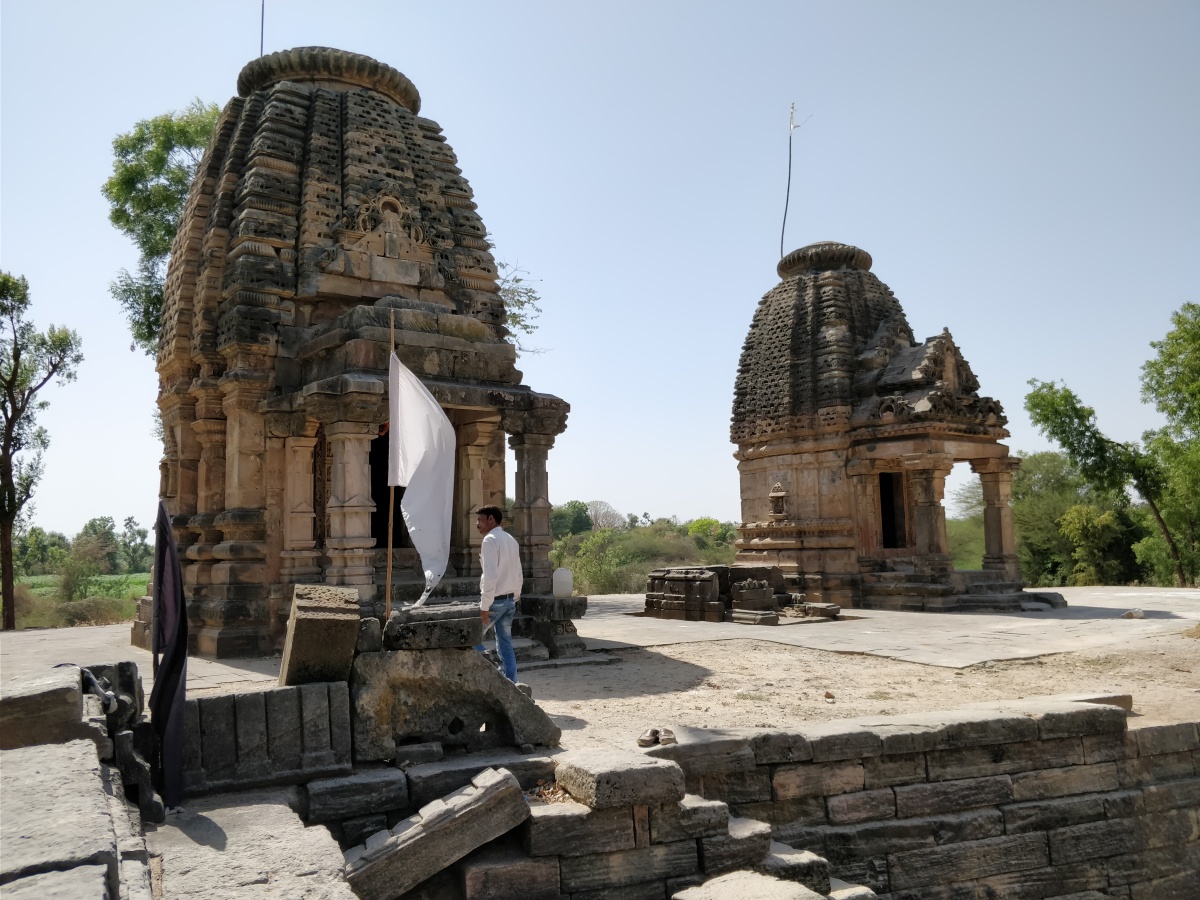Temple group is called as”great grandfather of Maru-gurjara style of architecture.”
Khed Roda is a Group of seven temples near Himmatnagar of Sabarkantha District.But locally it is said that there were more than 100 temples in this area. Most of them are completely vanished.

LOCATION:
These temples are built along the seasonal stream which merges with river Hathimati one km down. It may be possibility that this stream might have been important and flowing during construction of these temples.
Roda in Gujarati means brick-bats. This place was in obscurity. During first decades of 20th century, the brick bats are coming out of place was reported. Hence, this place was called as Roda group of temples. It was unknown till 1926 when archeologist named PA Inamdar studied this site. Later on another study was done by Mr. M A Dhaky in 1960s.These temples were called as ”great grandfather of Maru-gurjara style of architecture.”
WHO BUILT THESE TEMPLES?
These temples were built in 8-9th century during Gurjar-Prtihara or Rastrakuta period. There is a confusion which dynasty built these temples. The construction was taken placed during tri-partiate struggle years.If we accept the Rashtrakuta hegemony over Gujarat, we may have to find out the Rashtrakuta architecture in Gujarat. It will not logical to argue that the Rashtrakutas never built in Gujarat, as they have been the most voracious builders of the early medieval period. The Iconography influence of southern style indicates that most probably temples were built by Rastrakuta rulars.
MY EXPERIENCE:
During the hot summer of April, 2018 in Sabarkantha district, one of my Assignment was cancelled. So I decided to visit these temples. When I travel from Himmatnagar to these area, I missed the turn. There is very small borad indicating the direction installed by ASI. So by asking nearby people, we finally got the direction. The road is not metelled and runs along the boundaries of farms. In this hot summer water is the most important things you must carry.
Out of 7 temples, six are intact while one temple has its base only. These temples were given number for convenience of study and chronology of their construction.
At first while traveling around 1-2 km from main road, you get the two temples.
Temple I : Shiva temple
Temple II : Bird temple
Temple I :
The Temple No. I is nirandhara shrine with bi-partite offset (dwi-anga) plan configuration. It is situated on east-facing jagati (plinth). The entrance mandapa is of prag-griva style with four pillars. The inner sanctum is square. The plinth has moldings of bhita and pattika. The circumvention path (pradakshina) is provided by space on the plinth. The outer walls of the shrine is devoid of ornamentation. The mandapa has phansana type roof and the latina type spire over the main shrine has elaborate bold jala pattern carvings. It is topped by large amalaka.
Temple II:
The Temple No. II It has a phansana styled spire, not usual latina spire. It is called as bird temple.
Pakshi Mandir (No. II) which has no idols but carving of birds hence also known as bird temple. Temple No. II is the smallest temple among the group.
We have to travel ahead for five hundred meters towards stream. Here, you will find two intact temples and one in ruins. there is also a kund/water reservoir. When I was visiting this area, the work is undergoing by ASI. So I took one of ASI work inspector with me for more information. Many ruins were interspersed over the large area. Statues, torans, door frames,broken parts of temples etc.
Here in this area, Temple III,IV,V are located. The Temple III is dedicated to Shiva, Temple V to God Vishnu and temple IV is in ruins. Only its base is visible now. In front of these temples is a kund. This kund as four shrines in four corners of it. This ladushah kund (stepped reservoir may have been in center of another group of temples. These temples might have been of Surya and Goddess on another side of Kund. One image of God Surya is in Baroda Museum.
Temple III: this Shiva temple is in use now and large number of devotees come here on every shivratri. Temple No. III is almost similar to Temple No. I except its tri-partite offset (tri-anga) plan configuration.
Temple IV: It is in between Temple V and III. Smaller than other two. Only base ruins are there.

Temple V: I
t is a Vishnu temple. On the wall of garbhgraha,the sculptures of Narsimha,trivikram and varaha avatar of Vishnu can be seen.
Ladushah Kund:
The three temples III,IV,V are near to this kund. it is damged on northen side. When i visited this place ASI has restored its damaged side.
There are four shrines in four corners of Kund. These are of Vishnu,Goddess, Ganesh and Goddess?
Images of Sapta matrikas are also seen close to Ganesh shrine on East west side.
After taking ASI inspector along with me, I went along the water stream towards other two temples.
Temple VI: Navgraha Temple
This temple is on the opposite side that of temples III,IV,V. This is called as Navgraha Temple due to depiction of nine planets of astrology on the door frame of temple. Beautiful apsara are carved on mandapa. Hundreds of ruins are spread in nearby area of temple. There was a interesting pillar half buried in the soil. It has shown a carvings of Sun,Moon,A warrior fighting and a shaivite worshiping Shivling.
Temple VII:
Biggest temple of the group. It is a Shiva temple. This is approached by the water stream side on climbing the stairs carved in the rock. We can see the sculptures of Chamunda on right side of wall. Temple 7 doorway exhibits austerity in decoration with merely Lakulisha figure on the lalata bimba, with no decoration on the jambs. It was most austire door frame devoid of eleborate carvings. Temple has gudhmandapa.
It is further damaged during the Kutch Bhuj earthqauke in Gujarat.
Site Planning of Temple Group:
There is a high possibility that the Shiva Temple [Temple 7] on the southern extreme of the site did determine the axial pattern and the rest followed it. In that case, the chronological placement of the Shiva Temple should be preceding the other structures. At this point. the curving of the river is prominent near the Shiva Temple, the temple was definitely connected once with the river through stone steps (now ruined) leading to the river and lastly except Temple 6 and 7 all the Temples are away from the river. Among these structures Temples No.3, 4 and 5 has their sacred water resource that is a Kunda on the east. All temples are east facing.
Affinity with the water is evident in the temples except those near the Kunda. Temple 7 has jutting out makara heads on the corners of the adhishtana. Temples 6 and 2 follow this. These do not prompt Shah to place them in one group. He was more concerned with the projections of the mandovara. Before we go further into the analysis, it will be pertinent to reiterate the grouping of the previous scholars as Shah and Dhaky. Shah clusters Temple 1,3,5 and 6 in one group which he consider as belonging to be earlier phase. Temple 7 is kept separate for its prominent mukha mandapa. Temple 2 for Shah was an extension of the Maitraka activities and thus an outlaw in the Roda group.
Shah’s theory reads thus, “A study of the recesses of the walls of the Roda shrines points that temples Nos. 1, 4 and 6 fall in one group, having, on each wall, only one central offset, while in another group represented by temples Nos. 3, 5 and 7 are two offsets on each wall and temple No. 2, representing the third group, has no offsets at all. In the second group, it appears that portico of No. 6 was a later addition while No. 7 has a big sabha mandapa not seen in other temples of the group. There is a figure of Lakulisa in centre on top of the doorframe, and above the doorframe, in niches, are figures of Brahma, Kubera, Siva, Ganesa and Vishnu. Temple No. 7 is possibly later than the other shrines.”[6]
CHRONOLOGY:
When one tries to place the undated temples in the macro chronology of architecture development, especially in the case of Roda, it is the Temple 3 which has been the favorite of the architects of the consecutive years, not Temple 7. If Temple 7 was the most matured among the Roda group. If we group the temples into makara and non makara categories Temple Nos. 6, 7, 1 and 2 will come under the former and the rest of the temples near the kunda will be in the latter. There is a distinct stylistic affinity between the temples of these groups. Temple Nos. 7 and 6 are built on the River Hatimati with individual mounts and probably had separate access from the river. Temple Nos. 1 and 2 are built little away from the river, or appear so at present. As mentioned above the flooding or drying of the river would have been a major concern. The intention of symbolically keeping the temple afloat during the monsoons is clear with the makara motifs at the corners. The temples of the other group satisfy this water symbolism with Kunda in the front like Sankara’s kamandalu would protect the temples by encompassing the floodwater in it.
This is a must visit place for travelers,temple and history lovers.
Disclaimer:
I am an enthusiast and not a subject scholar.
Sources:
https://en.wikipedia.org/wiki/Roda_Group_of_Temples
https://books.google.co.in/books?id=CtDLDAAAQBAJ&pg=PA42&redir_esc=y#v=onepage&q&f=false
http://historyandarts.blogspot.in/2007/01/roda-group-of-temples.html
https://sabarkanthadp.gujarat.gov.in/sabarkantha/roda-himtnager.htm
























Wonderful..👌👌
roda temple Himatnagar watch full video in youtube.
link. https://youtu.be/Tw3gxUvgpAM